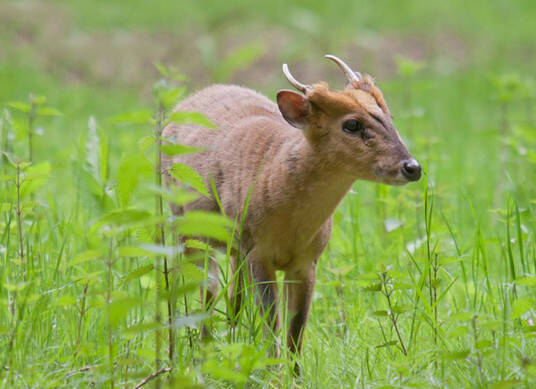Muntiacus reevesi
IUCN
LCBasic Information
Scientific classification
- name:Muntiacus reevesi
- Scientific Name:Muntiacus reevesi,Chinese Muntjak,Formosan Reeves' Muntjac、Reeve’s Muntjac、Reeves's Muntjac,Mountain barking deer, dog muntjac, horned muntjac, yellow muntjac, mountain muntjac
- Outline:Ungulata
- Family:Artiodactyls Cervidae Muntjac
Vital signs
- length:70-87cm
- Weight:9-18kg
- lifetime:About 20 years
Feature
The head is bright brown, the body hair is tan, and the nape of the neck is darker and dark brown.
Distribution and Habitat
The small muntjac is mainly distributed in the provinces south of the Yangtze River in China. The nominate subspecies is distributed in Anhui, Henan, Shaanxi, Gansu, Sichuan, Jiangsu, Zhejiang, Fujian, Guangdong, Guangxi, Hunan, Jiangxi, Hubei, Guizhou, and Yunnan; the Taiwan subspecies is distributed in Taiwan Province; the Jiangkou subspecies is distributed in Fanjing Mountain, Guizhou.
It lives in dense bushes.
Appearance
The little muntjac is the smallest type of muntjac, with a height of about 43-52 cm, a body length of 70-87 cm, a weight of 9-18 kg, and a long tail of 12 cm. The face is short and wide, and the frontal glands are short and parallel. There is a black line in the center of the nape of the neck. The male has horns, but the horns are short and the tips are curved inward and downward. The infraorbital gland is large and has a meniscus-shaped slit. Its rear end curves backward into a shallow groove until the front edge of the eye socket. Its opposite end is slightly "S" shaped toward the middle of the front of the face, bending toward the slit. middle part. The middle part of the meniscus-shaped crack is shallower than the two ends.
The skull of the lesser muntjac is short and wide, about one-third smaller than that of the red muntjac. The tear socket is extremely large, even exceeding the eye socket, occupying most of the lacrimal bone, leaving only the narrow upper edge of th
Details
Muntiacus reevesi (scientific name: Chinese Muntjak, Formosan Reeves' Muntjac, Reeve's Muntjac, Reeves's Muntjac), has three subspecies and is a small deer animal.

The activity pattern of the small muntjac is similar to that of the red muntjac. It is an animal active during the day, and it is also most active in the morning and evening. Therefore, it calls more during this period. Although its call is similar to a dog barking, it has a higher pitch. The small muntjac is very cautious when foraging and usually sneaks slowly. It feeds on branches, leaves, and young shoots of a variety of shrubs, trees, and herbs, as well as flowers and fruits.
The young muntjac reaches sexual maturity at 7-8 months of age and breeds all year round. The gestation period is 6 months, with 1-2 pups born each time. The pups have light white spots, which gradually disappear after a few months. During the breeding season, males can make "ga, ga" sounds and fight for mates.
In October 2020, the National Forestry and Grassland Administration issued the "Notice on Standardizing the Scope of Classification and Management of Prohibited Wild Animals", prohibiting the breeding of this animal for the purpose of eating, and guiding breeders to stop breeding except for special circumstances such as retaining a proper amount of seed sources.
The wild muntjac is listed in the "National List of Terrestrial Wildlife with Important Economic and Scientific Research Value" issued by the State Forestry Administration of China on August 1, 2000.
Listed in the 2008 Red List of Endangered Species of the World Conservation Union (IUCN) ver 3.1 - Least Concern (LC).
Listed in the China Biodiversity Red List - Vertebrate Volume, with an assessment level of Near Threatened (NT).
Protect wild animals and stop eating game.
Maintaining ecological balance is everyone's responsibility!








